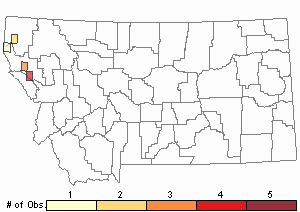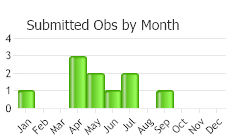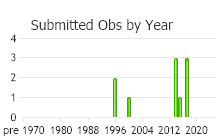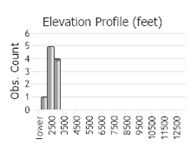View in other NatureServe Network Field Guides
NatureServe
Montana
Utah
Wyoming
Idaho
Wisconsin
British Columbia
South Carolina
Yukon
California
New York
Umbrella Moss - Leucolepis acanthoneuron
Other Names:
Leucolepis menziesii
General Description
Plant: Acrocarpous (Vitt 1988), dendroid, dark green, and often in tufts. Erect stems are 4-8 cm tall, red-brown to black, and with abundant brown rhizoids. Upper portion of stem with numerous branches, each about 1.5 cm long, and appears like a miniature tree.
Leaf: Upper stem leaves (below branches): 3 x 1.5 mm, broadly ovate-lanceolate, acuminate, and decurrent (about 0.5 mm). Lower stem leaves: 2.5-3.0 x 1 mm, appressed, ovate-lanceolate, acuminate with a long, narrow, & hyaline hair-point, and decurrent (about 1 mm). Lower stem leaves have plain, sharply toothed margins; teeth occur at right angles to margin and make a weak border. Branch leaves: 1.5-2.0 x 0.8-1.0 mm, crisped when dry, ovate-lanceolate, decurrent, and with a short, acute apex. Branch leaves have toothed margins (except not at base) that form a weak border. Costa ends before the apex and is toothed on back.
Leaf Cells: Median cells 17-25 x 12-17 µm, with thick walls that are thickest at the corners (collenchymatous).
Phenology
Capsules ripen in spring-summer (FNA 2014).
Diagnostic Characteristics
Their dendroid growth habit gives L. acanthoneuron plants the look of miniature palm trees. Another dendroid moss, Climacium dendroides, with its upright capsules and rounded stem leaf apices, differs from L. acanthoneuron, which has drooping capsules and acute apices (FNA 2014).
Range Comments
Leucolepis acanthoneuron is a [North American] Pacific Coast endemic (Koponen 1974; Lawton 1971) from British Columbia south to California. Canada: BC; USA: AK, CA, ID, OR, WA (FNA 2014). In Montana: Glacier, Lincoln, and Sanders Counties (Elliott 2016).
Observations in Montana Natural Heritage Program Database
Number of Observations: 10
(Click on the following maps and charts to see full sized version)
Map Help and Descriptions
Relative Density

Recency



 (Observations spanning multiple months or years are excluded from time charts)
(Observations spanning multiple months or years are excluded from time charts)
Habitat
Substrate: Humus in shaded habitats (Elliott 2016), soil, rocks, rotten logs, and tree trunks (FNA 2014). Usually below 3,300 feet.
Reproductive Characteristics
Seta is 4-5 cm long, red-brown. Capsule pendent, broadly cylindric, light to dark brown, and 6-8 mm long. Dioicous. The sex organs are surrounded by bracts and branches.
Stewardship Responsibility
References
- Literature Cited AboveLegend:
 View Online Publication
View Online Publication Elliott, J.C. and A.K. Pipp. 2018. A Checklist of Montana Mosses (1880-2018). Updated 3 January, 2020. Montana Natural Heritage Program, Helena, Montana. 73 pp.
Elliott, J.C. and A.K. Pipp. 2018. A Checklist of Montana Mosses (1880-2018). Updated 3 January, 2020. Montana Natural Heritage Program, Helena, Montana. 73 pp. Flora of North America Editorial Committee, eds. 2014. Flora of North America North of Mexico. Volume 28. Bryophytes: Mosses, Part 2. Oxford University Press, Inc., NY. xxi + 702 pp.
Flora of North America Editorial Committee, eds. 2014. Flora of North America North of Mexico. Volume 28. Bryophytes: Mosses, Part 2. Oxford University Press, Inc., NY. xxi + 702 pp. Koponen, T. 1974. A guide to the Mniaceae in Canada. Lindbergia 2: 160-184.
Koponen, T. 1974. A guide to the Mniaceae in Canada. Lindbergia 2: 160-184. Lawton, E. 1971. Moss Flora of the Pacific Northwest. Hattori Botanical Laboratory. Japan: Yamabuki-cho, Shinjuku-ku, Tokyo. 362 pages plus appendices.
Lawton, E. 1971. Moss Flora of the Pacific Northwest. Hattori Botanical Laboratory. Japan: Yamabuki-cho, Shinjuku-ku, Tokyo. 362 pages plus appendices. Vitt, D. J. Marsh, and R. Bovey. 1988. Mosses, Lichens & Ferns of Northwest North America. Seattle, WA: University of Washington Press. 296 p.
Vitt, D. J. Marsh, and R. Bovey. 1988. Mosses, Lichens & Ferns of Northwest North America. Seattle, WA: University of Washington Press. 296 p.
- Additional ReferencesLegend:
 View Online Publication
View Online Publication
Do you know of a citation we're missing? Elliot, J. C. 1993. Second checklist of Montana mosses. Unpublished report. U.S. Forest Service, Region 1. Missoula, MT. 45 pp.
Elliot, J. C. 1993. Second checklist of Montana mosses. Unpublished report. U.S. Forest Service, Region 1. Missoula, MT. 45 pp. Lawton, E. 1971. Keys for the Identification of the Mosses on the Pacific Northwest. Reprinted from 'Moss Flora of the Pacific Northwest'. Published as Supplement No. 2 of the Journal of the Hattori Botanical Laboratory. Nichinan, Miyazaki, Japan. 66 pp.
Lawton, E. 1971. Keys for the Identification of the Mosses on the Pacific Northwest. Reprinted from 'Moss Flora of the Pacific Northwest'. Published as Supplement No. 2 of the Journal of the Hattori Botanical Laboratory. Nichinan, Miyazaki, Japan. 66 pp.
- Web Search Engines for Articles on "Umbrella Moss"





